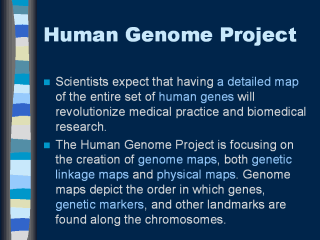|
|
|
|
front |1 |2 |3 |4 |5 |6 |7 |8 |9 |10 |11 |12 |13 |14 |15 |16 |17 |18 |19 |20 |21 |22 |23 |24 |25 |26 |27 |28 |29 |30 |31 |32 |33 |34 |35 |36 |37 |38 |39 |40 |Glossary |review |
 |
An international 15-year collaboration known as the Human Genome Project. (The
United States effort is shared by the National Center for Human Genome Research
at the National Institutes of Health and the Office of Health and Environmental
Research of the Department of Energy.) Genetic linkage maps assign chromosomal locations to genetic landmarks - either genes or distinct short sequences of DNA - on the basis of how frequently markers are inherited together. Linkage maps exploit a phenomenon called recombination or crossing over. As developing sperm and egg cells divide, pairs of maternal and paternal chromosomes sometimes break and exchange pieces with one another. Genes and markers that are physically close to one another on the chromosome are said to be tightly linked; they are much less likely to be separated by recombination than are gene markers that are located far apart. In 1994, international collaborators published a comprehensive linkage map charting more than 5,000 markers and more than 400 genes. After scientists use genetic linkage maps to assign a gene to a relatively small area on a chromosome, they next examine the region up close to learn the gene's precise location. To do this, scientists turn to physical maps. To construct a physical map, a chromosome (or in some cases, the whole genome) is first broken into smaller pieces of DNA. Scientists then copy or clone the pieces in the laboratory, obtaining millions of identical copies of specific DNA segments. They next line up the clones to reflect the order that existed on the original chromosome. Information about the location and known genetic content of these unique and ordered DNA fragments (called contigs) is stored in a computer, while clones of the ordered pieces themselves are stored in laboratory freezers. When genetic linkage maps indicate that a gene lies in a particular region, scientists can go to the freezer and retrieve clones of interest; they then use the clones as the raw material for DNA sequencing - actually identifying the order of each and every chemical base in the gene. Benefiting from the increasingly detailed maps and sophisticated DNA sequencing techniques and tools, scientists are mapping and isolating new disease genes at the rate of several per month. By the year 2005, scientists hope to pinpoint the location of each of the 50,000 to 100,000 genes and to identify the exact sequence of their chemical bases. |